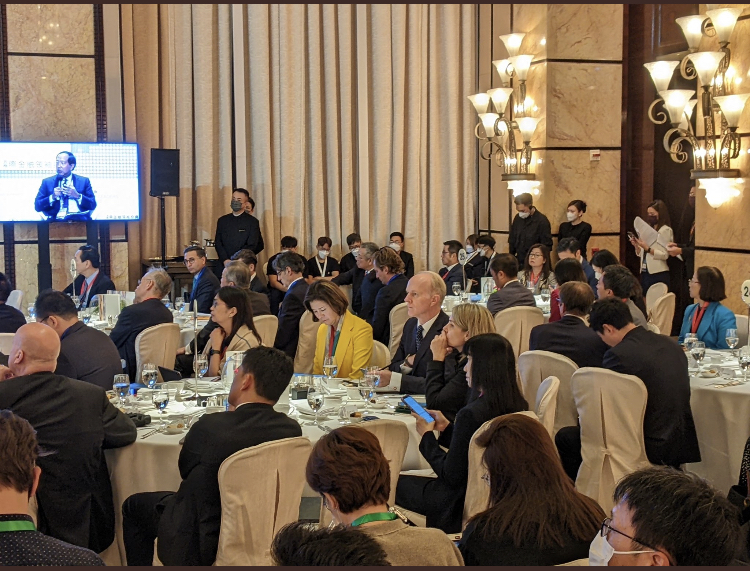"I think, therefore I am,” said Rene Descartes. While the French philosopher was focusing on nothing less than the profound nature of human existence, his words also reflect other less abstract truths.
Our personalities, identities, our perceptions of the world around us and our place in it, are all absorbed, filtered, processed and repackaged in a mass of grey matter packed in our skulls. Ensuring that we get the best out of this 1.5kg of precious human tissue seems to get harder as modern life becomes more complex.
The constant bombardment of our senses with stimulation, the torrent of irrelevant information in our email inboxes and on our screens, the media obsession with the sound-bite and the ten-second attention span created by the pressures of our hectic daily schedules, all work to weaken our focus and undermine our ability to reflect.
So how do meeting planners and conference organisers swim against the stream? How do they ensure that delegates receive the message loud and clear and remember it, long after the seminar has finished?
A number of experts have spent a great deal of effort, learning from human psychology to suggest ways of maximising conference and meeting resources.

The long-standing trade-off between creatively engaging and expanding delegates’ mental capacities and simply filtering corporate messages and visions is tricky to handle. On the one hand, while many clients outwardly profess their receptiveness to innovative methods of educating and motivating their employees, key decision-makers can be wary of ceding too much “thought control” to external parties – especially when it involves hiring someone from overseas to come and address company members. Too often, companies choose the familiar “tangible” information overload presentation option, rather than trusting “intangible-result” conferencing, where delegates are afforded mental space to form their own responses.
The rising demand for original meetings in Asia-Pacific is to some degree a result of regional economic growth. Companies in every country, are competing to recruit, train, motivate and retain staff across all disciplines. In this context, conferences, incentives and company retreats are more frequently being used not just to download corporate sales figures and year-end targets, but also to deliver more inspirational messaging to optimise mental creativity and the untapped powers of the human mind.
“If you never change your mind, why have one?” is a signature quote from creative thinking leader and author Edward de Bono. In September, New Zealand-based events company Red Carpet took its “Up Close” seminar series with de Bono to Mumbai, Bangalore, Delhi, Beijing and Shanghai. In Shanghai, local business people could – for the princely sum of RMB5,000 (HK$5,170) – listen to and interact with the so-called “pioneer of the concept of lateral thinking” during a one-day seminar.
The marketing text for de Bono’s seminars perfectly encapsulated the current maelstrom of views on creative corporate thought in Asia, suggesting that the challenges created by accelerating social change and economic growth can only be countered by implementing imaginative solutions. “Traditional thinking is to do with analysis, judgment and argument. In a stable world this was sufficient,” Red Carpet says. “This is no longer so in a changing world where the standard solutions may not work.”
When adapted resourcefully, the capacity for expanded thought is a powerful meetings tool. “We believe that diversity of thought and behaviour, coupled with able leadership in a non-threatening environment is the best way to ensure a more productive and creative team,” explains Joshua Teo, CEO of Singapore-based Emergenetics Asia, a consulting company that uses profiling instruments and concepts based on scientific research about human thought and behaviour.
“As a result, our value-proposition is ‘Whole People-Whole Teams.’ Putting together diverse peoples gives you the basics of a successful, sustainable and strong team that can bring about a more wholesome approach to solving corporate challenges,” says Teo.
Emergenetics speaks at several business forums in Singapore, Thailand and Malaysia, and has provided corporate-based workshops and seminars for clients such as Standard Chartered Bank and the Singapore Prison Service. “In the last two and a half years in Asia, we have seen the market embrace this style of training,” notes Teo. “And, after tracking the results, feedback from our direct customers and the associate network has been better than our expectations.”
One of the company’s recent presentations was for Singapore’s National Community Leadership Institute. Titled, The New Psychology of Creative Leadership, it focused on the theme of practical neuroscience. “Neuroscience has long proven that male and female thinking patterns, behaviours and perspectives are radically different, brain-based and hardwired,” says Teo.
It is hardly surprising then that this also extends into the realm of leadership. Based on 17 years of research, Emergenetics found that there is no ideal profile for a leader, be it a man or woman. “This workshop session shows that great minds do not think alike, as it illustrates the unique profiles of leaders from all over the world – from successful Fortune 100 senior managers to social enterprise leaders, to business owners,” says Teo.
Learning to learn
The applications of brain-based learning for meetings and conferences are myriad. “As we grow past the age of 25, our brains are increasingly hardwired with a certain set of learning rules that make the absorption and accumulation of our thought processes predictable to a certain extent,” explains Teo. “We then communicate these thoughts in similarly predictable ways. It is important to provide practical suggestions for organisations to develop creative leaders, given the unique neuropsychological makeup of the human race.”
Tapping into human psychology can be effectively adapted to almost any meetings situation – from sales training to executive team building, incentive programmes to food and beverage (F&B) strategy planning. In June Starwood Hotels held its first regional F&B conference, aptly named, The Next Course: Let’s Taste the Future Together, in Bangkok. Attended by more than 350 F&B directors, executive chefs, and other professionals from the company’s hotels, GM and divisional teams, the conference aimed to engage minds and inspire employees’ creative instincts.
“We started the conference with the topic of ‘the power of memory’, with a vision that this would give the audience a few easy-to-use tools throughout the conference – and, hopefully, get them to remember what it was all about,” says Martin B Jones, managing director, Food and Beverage, Starwood Asia-Pacific, who devised and ran the programme.
The conference required all attendees to understand fully, and adopt in practice, the company’s new vision. It also sought to avoid being “a pure F&B download” format, as the focus was on developing a broad range of topics about the business and new thinking about the way it will be managed in future. “Our people are a key focus, so to nurture the talent we have, and attract the talent we want, we all need to be on the same page,” Jones says. “F&B is an extremely creative business, so sitting still for hours on end being downloaded to just doesn’t work.”?In this context, activity, information, vision, fun and stimulation – “with an emphasis on fun” – were key elements.
The Bangkok F&B conference menu featured keynote presentations by Glenn Capelli, a creative thinking expert who held a workshop exploring the practical side of unlocking creativity through creating emotionally smart environments and inspired leaders; and Scott Bornstein, a memory power expert who teaches brain-changing skills to executives and professionals worldwide.
These presentations formed a foundation base for other practical meeting sessions. “We followed the keynotes with workshops so that delegates could gain more take-aways for use back in the work environment,” explains Jones. “The speakers were amazing individuals with true talent, passion, drive, focus, and were excellent at teaching. It was also a great deal of fun, which made it easier to absorb.”
Expert opinion
In addition to the Starwood presentation, Perth-based creative thinking specialist Glenn Capelli has presented to corporate audiences around the globe. His recent engagements range from the Orthodontics International Conference in Canberra to the New Zealand Road Contractors Federation, the International Crematoria Conference in Darwin to a finance industry gathering in Miami.
“Companies often take the messages and strategies and layer them throughout the organisation. My work could be running my Dynamic Leadership Programme, assisting with how the messages spread through the organisation, designing multi-stimulating and multi-media back-up learning, doing one-to-ones with some senior executives, or running some Young Guns sessions,” he explains.
Capelli has authored e-books titled, Philosophically Speaking and The Thinking Learning Classroom, and a CD of songs and music for developing self esteem, thinking and learning skills. He also coaches other speakers. “I coach a number of professional speakers and always tell them that ‘You will not reach 100 per cent of the people in a room with 100 per cent depth.’ There are always learners who need to reject a message before they accept, others who have big issues on their minds at that moment,” Capelli says.
He adds that learning methodology research reveals, “learning seeps in through suggestion, repetition and variety. When you present with diverse methodology, and do so with respect, depth and humour, the brain soaks in more and the barriers thaw.” Breaking down those mental barriers helps you “reach unexplored treasures”.
Laugh it Off
Humour, in particular, is a powerful instrument for helping an audience to relax and participate in a presentation, rather than just sitting back and absorbing information. “Laughter opens the brain and heart and has the mind stretch sideways,” Capelli says. “It really helps when you are presenting to the human being wrapped inside the corporate person”.
All jokes aside, creative thought presentations must adhere to the methodology outlined after years of research in order to provide the required audience stimulation and deliver client goals. “I love to gather a background of the industry for which I will be speaking, the context of how the company’s world is at the moment, and the history of the group. I am a former history teacher, and believe lessons from and knowledge of the past is vital,” says Capelli. “Of course, I also want to know the purpose of the gathering, the mix of people attending, the morale of the moment and the challenges being faced.”
Capelli explains that while collecting background information, no matter what a person seems to be on the outside, “somewhere inside everyone there are unexplored talents”.
Key considerations for any event manager, he says, are “the potentials of empathy and compassion and an innate love for challenge. The human brain loves a challenge”.
DO
l Research the market carefully. There are scores of creative thinking speakers offering their services to events companies, but not all may be able to satisfy your particular conference goals.
l Ask if the speaker has any special dietary, medical or other requirements that need to be catered to.
l Pitch creatively and sensitively, and be prepared for an initially frosty response from senior decision-makers. Never give up, but do be tactful and imaginative in your initial discussions – and always try to express the practical benefits from other similar events as persuasive collateral.
l Provide creative thought speakers with sufficient information about the conference delegates, objectives and company history so they can tailor their presentation accordingly.
l Encourage key client decision-makers to buy into and promote the “creative thinking, brain-training” concept. Top-down support is crucial to prevent skepticism about this form of event presentation.
l Check out potential speakers’ websites. Many creative thought speakers are also comedians, authors, songwriters and/or television presenters, and they often have content-rich and entertaining websites that provide a clear look at whether they will be appropriate to address your event
DON’T
l Be afraid to experiment. Creative thinking presentations are an area with which many companies are unfamiliar – and this may give you more room to innovate once you have an initial agreement in place.
l Be afraid to experiment. These types of presentations are relatively new to the mainstream market, and this may give you more room to be creative once you have an initial agreement with someone in place.
l Leave it too late. The region’s top creative speakers are in high demand worldwide, so you might need to book them several months out.
l Neglect the conference scheduling. Consult with the contracted creative thinking speaker to determine at which stage of an event his/her presentation will be most effective.
l Forget to get feedback. Delegates unfamiliar with the mind-expanding presentation approach often provide unexpected and valuable responses that can help when creating future events.
l Confine creative thinking to a sales conference environment. It can also form an effective part of a teambuilding or incentive programme.


